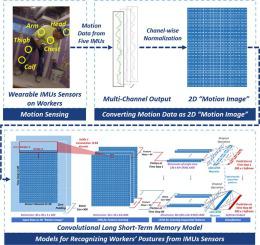Advanced Engineering Informatics ( IF 8.0 ) Pub Date : 2020-09-24 , DOI: 10.1016/j.aei.2020.101177 Junqi Zhao , Esther Obonyo

|
This paper proposes using Deep Neural Networks (DNN) models for recognizing construction workers’ postures from motion data captured by wearable Inertial Measurement Units (IMUs) sensors. The recognized awkward postures can be linked to known risks of Musculoskeletal Disorders among workers. Applying conventional Machine Learning (ML)-based models has shown promising results in recognizing workers’ postures. ML models are limited – they reply on heuristic feature engineering when constructing discriminative features for characterizing postures. This makes further improving the model performance regarding recognition accuracy challenging. In this paper, the authors investigate the feasibility of addressing this problem using a DNN model that, through integrating Convolutional Neural Networks (CNN) with Long Short-Term Memory (LSTM) layers, automates feature engineering and sequential pattern detection. The model’s recognition performance was evaluated using datasets collected from four workers on construction sites. The DNN model integrating one convolutional and two LSTM layers resulted in the best performance (measured by F1 Score). The proposed model outperformed baseline CNN and LSTM models suggesting that it leveraged the advantages of the two baseline models for effective feature learning. It improved benchmark ML models’ recognition performance by an average of 11% under personalized modelling. The recognition performance was also improved by 3% when the proposed model was applied to 8 types of postures across three subjects. These results support that the proposed DNN model has a high potential in addressing challenges for improving the recognition performance that was observed when using ML models.
中文翻译:

卷积长短期记忆模型,用于从可穿戴惯性测量单元中识别建筑工人的姿势
本文提出使用深度神经网络(DNN)模型从可穿戴式惯性测量单元(IMU)传感器捕获的运动数据中识别建筑工人的姿势。公认的尴尬姿势可能与工人中肌肉骨骼疾病的已知风险有关。应用基于常规机器学习(ML)的模型在识别工人的姿势方面已显示出令人鼓舞的结果。ML模型是有限的–在构造用于表征姿势的区分性特征时,它们会响应启发式特征工程。这使得进一步提高关于识别精度的模型性能具有挑战性。在本文中,作者研究了使用DNN模型解决此问题的可行性,该模型通过将卷积神经网络(CNN)与长短期记忆(LSTM)层集成在一起,使特征工程和顺序模式检测自动化。使用从四名建筑工地工人收集的数据集评估了模型的识别性能。结合了一层卷积层和两层LSTM层的DNN模型产生了最佳性能(以F1分数衡量)。所提出的模型优于基线CNN和LSTM模型,表明该模型利用了两个基线模型的优势进行有效的特征学习。在个性化建模下,它将基准ML模型的识别性能平均提高了11%。当将建议的模型应用于三个对象的8种姿势时,识别性能也提高了3%。











































 京公网安备 11010802027423号
京公网安备 11010802027423号